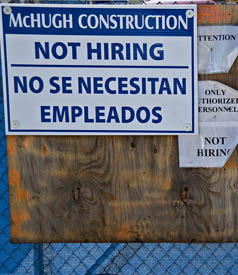
|  |  |  Editorials | Issues | November 2009 Editorials | Issues | November 2009  
US Unemployment Hits 10.2 Percent, Economy Sheds 190,000 Jobs
 Dean Baker - The Center for Economic and Policy Research Dean Baker - The Center for Economic and Policy Research
go to original
November 07, 2009


| | A sign of the times. (swanksalot/flickr) |  |
The strong wage growth reported for October was probably an aberration.

The unemployment rate crossed 10.0 percent for the first time since early 1983, hitting 10.2 percent in October. The establishment survey showed the economy losing another 190,000 jobs, with most of the job loss in construction and manufacturing.

The October unemployment rate is still below the 10.8 percent peak reached in December of 1982, but the workforce is considerably older now and in age cohorts where workers are less likely to be unemployed. If the workforce had the same age distribution as in 1982 but current unemployment rates for each age cohort, then the unemployment rate would be more than a percentage point higher. The 10.7 percent unemployment rate for men is 0.6 percentage points higher than the 10.1 percent peak in 1982. This is consistent with the massive job loss in construction and manufacturing.

The unemployment rate for women is 8.1 percent. In an unusual turnaround, the employment to population ratio (EPOP) for white women, at 55.7 percent, is now 0.9 percentage points higher than the EPOP for black women. Before July of this year, black women had always had higher EPOPs.

By education, those with some college have taken the biggest hit in recent months, with their unemployment rate rising by 0.5 percentage points to 9.0 percent in October. It had been 7.9 percent in July.

The number of people involuntarily employed part-time rose by 190,000. This helped to push the U-6 measure of labor market slack up 0.5 percentage points to 17.5 percent, another record. The average period of unemployment rose by 0.7 weeks to 26.9 weeks, with the median rising by 1.4 weeks to 18.7 weeks, both new records.

The 190,000 job loss reported in the establishment survey is somewhat offset by an upward revision of 171,000 to the job loss data for the prior two months. The new data put job loss for August and September at 154,000 and 219,000, respectively, so it is not clear that the rate of job loss is on a downward path.

The 61,000 jobs lost in manufacturing is actually above the 47,000 average for the prior three months. Similarly, the 62,000 jobs lost in construction is far above the 34,000 average for the prior three months. Within construction, job loss has overwhelmingly switched to the non-residential side, which shed 33,400 jobs in October. The stimulus related jobs are being overwhelmed by cutbacks in construction of retail and office space. The job loss within manufacturing was broadly based. The auto sector actually showed a small "cash-for-clunkers"-induced gain of 4,000 jobs. However, its current employment of 663,700 workers is almost exactly half of its level from 10 years ago.

Retail lost 39,800 jobs, with sporting goods and hobby stores being especially hard hit with a loss of 15,800 jobs, 2.6 percent of employment in the sector. State and local governments shed 16,000 jobs in October, which was offset by an increase in federal government employment of the same amount. One ominous sign was a drop of employment in trucking of 7,500 jobs, approximately 0.6 percent. This could suggest a big falloff in the amount of goods being shipped.

On the positive side, there was a modest uptick in manufacturing hours of 0.1 per week, with overtime rising by 0.2 hours. Also, jobs in employment services increased by 33,700, which, coupled with prior months' revisions, gives three consecutive months of increase.

Another piece of good news was a 0.5 percent rise in the average hourly wage. This brought the annual rate of increase over the last three months to 2.8 percent. This would be very good news if it is maintained since it would imply that wages are at least keeping pace with inflation. However, this figure is most likely an aberration and will probably be reversed either by revisions to the data or offset by weak reported wage growth in November.

In all likelihood, the economy will continue to shed jobs, at least through the rest of the 2009 and probably into the first months of 2010. The unemployment rate will probably not peak until the spring of next year, at close to 11.0 percent. |

 |
|  |



